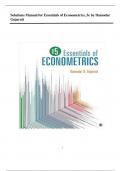Solutions Manual for Essentials of Econometrics, 5e by Damodar
Gujarati
PR
O
FD
O
C
1
, CHAPTER 1
THE NATURE AND SCOPE OF ECONOMETRICS
QUESTIONS
1.1. (a) Other things remaining the same, the higher the tax rate is, the lower
the price of a house will be.
(b) Assume that the data are cross-sectional, involving several residential
communities with differing tax rates.
(c) Yi = B1 + B2 X i
where Y = price of the house and X = tax rate
(d) Yi = B1 + B2 X i + ui
PR
(e) Given the sample, one can use OLS to estimate the parameters of the
model.
(f) Aside from the tax rate, other factors that affect house prices are
mortgage interest rates, house size, buyers’ family income, the state of the
O
economy, the local crime rate, etc. Such variables may be included in a more
detailed multiple regression model.
FD
(g) A priori, B2 < 0. Therefore, one can test H0 : B2 0 against H1 : B2 < 0.
(h) The estimated regression can be used to predict the average price of a
house in a community, given the tax rate in that community. Of course, it
O
is assumed that all other factors stay the same.
1.2. Econometricians are now routinely employed in government and business
C
to estimate and / or forecast (1) price and cost elasticities, (2) production
and cost functions, and (3) demand functions for goods and services, etc.
Econometric forecasting is a growth industry.
1.3. The economy will be bolstered if the increase in the money supply leads to
a reduction in the interest rate which will lead to more investment activity
and, therefore, to more output and more employment. If the increase in the
money supply, however, leads to inflation, the preceding result may
2
, not occur. The job of the econometrician will be to develop a model to
predict the effect of the increase in the money supply on inflation, interest
rate, employment, etc.
1.4. As a matter of fact, on October 1, 1993 the Federal Government did increase
the gasoline tax by 4 cents. Since gasoline and cars are complementary
products, economic theory suggests that an increase in the price of gasoline
will not only lead to a decline in the demand for gasoline but also in the
demand for cars, ceteris paribus. The Ford Motor Companymay be advised
to produce more fuel-efficient cars to stave off a serious decline in the
demand for its cars. An automobile demand function will provide numerical
estimates of the effect of gasoline tax on the demandfor automobiles.
PR
1.5.
There are many alternative designs possible. However, to keep things
simple, and discuss just a basic idea of the design, we could think of using
an econometric model known as Autoregressive Distributed Lag (ARDL)
O
of the form:
y = + y + g + g + p + + p + c + c + u
FD
t t −1 0 t 1 t −1 0 t 1 t −1 0 t 1 t −1 t
where
Yt − Yt −1
yt = = real GDP growth rate in year t;
Yt −1
O
Gt − Gt −1
gt = = real government infrastructure investment growth rate in
Gt −1
C
year t;
tp = personal income tax rate in year t;
tc = corporate income tax rate in year t;
yt = yt − yt −1 = change in real GDP growth rate in year t;
gt = gt − gt −1 = change in real government infrastructure investment growth
rate in year t;
p = p − p = change in personal income tax rate in year t;
t t t −1
c = c − c = change in corporate income tax rate in year t.
t t t −1
Expected signs and magnitudes of the parameters the regression model:
3
, 0 1;
0,1 0;
0,1,0,1 0.
Note that a more realistic model would include a larger number of lags of the
regressors than included in our model, and would also include additional
regressors known as control variables which could be determined based on
economic theory.
Now, based on our specified model above, short run and long run economic
consequence of 1 unit increase in g , p , and c , respectively, can be
t t t
determined by using partial derivatives as follows.
Short run economic consequences of a 1 unit increase in gt are given by:
yt
PR
= 0 ;
gt
yt +1 (yt + 1gt )
= = 0 + 1;
gt gt
yt + 2 (yt +1 )
= = ( 0 + 1 );
O
gt gt
yt +3 (yt + 2 ) (yt + 2 )
=
= = 2 ( 0 + 1 );
gt gt gt
FD
and so on.
Long run consequence is the sum of short run consequences
= 0 + ( 0 + 1) + ( 0 + 1) + 2 ( 0 + 1) + ...
= 0 + 0 + 1+ 2 0 + 1+ 3 0 + 2 1 + ...
O
= 0(1 + + 2 + 3 + ...) + 1(1 + + 2 + ...)
0
= + 1
C
1− 1−
+
= 0 1.
1−
Analogously, short run economic consequences of a 1 unit increase in tp are
given by:
yt
= 0;
tp
y (y + p )
t +1
= t 1 t
= 0 + 1;
t p
tp
4




